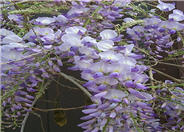
Common name:New Zealand Flax
Botanical name:Phormium tenax
New Zealand Flax is a large, bold plant with stiffly vertical, sword-like, green leaves that arise from its base. It should be grown under full sun for best color. Varieties will offer different growth habits and leaf color.

Common name:Flowering Maple, Chinese Lantern
Botanical name:Abutilon hybrids
These evergreen shrubs usually grow to 8-10' tall and as wide. Most will tolerate frost to 25 degrees F or lower with some damage. All are irresistible to hummingbirds with their showy flowers and heavy nectar production. They will take sun to moderately deep shade and little or no summer watering in coastal areas. They should be given more shade and water in hotter, drier climates. They make an excellent plant for containers or hanging baskets. -Monterey Bay Nursery

Common name:Ginkgo Tree, Maidenhair Tree
Botanical name:Ginkgo biloba
The Ginko biloba, with its distinct fan-shaped leaves, initially grows with a pyramidal habit, but later becomes wide-spreading. It is generally not bothered by insects or disease.

Common name:Chinese Wisteria
Botanical name:Wisteria sinensis
While the sinensis is similar to the floribunda, it bears more rounded, full clusters of strongly fragrant flowers which open more or less all at once. There are usually 13-15 leaflets per leaf, and they require full sun and average to little watering. It comes in many colors in the blues, whites and purples.-Monterey Bay Nursery
| Designer: | Afternoon Tea Space |
Photographer: GardenSoft |
Soils and Compost:
Maintain a two to four inch layer of mulch on the soil surface to reduce weeds, infiltrate rain water, and reduce compaction.
Water Saving Tip:
Use water saving equipment, e.g. rain or soil-moisture sensors, MP rotator nozzles, weather-based controllers, and low-volume irrigation (drip systems, soaker hoses, and microsprayers).
Integrated Pest Management:
Remove irrigation water and fertilizer from areas where you don't want weeds to grow.
